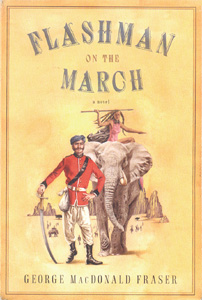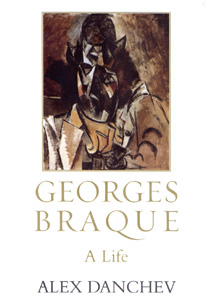![[whitespace]](/gifs/whiteline2.gif) |
Book Box

Flashman on The March
After the almost posthumously weak last book, Flashman and the Tiger, the new Flashman on the March marks an invigorating return to form by Fraser. This 12th installment of the "Flashman Papers" concerns a startling forgotten incident. The 1868 Abyssinian war was inaugurated by a British diplomatic bungle. The seemingly doomed hostage-rescuing operation was a British attack against the Coptic King Theodore II, a monarch Fraser paints as Africa's answer to Ivan the Terrible. As in the previous 11 books, Col. Harry Flashman distinguishes himself with sardonic snobbery. He falls into bed with both a warrior princess and her sister, the well-fed Queen Masteeat; in between, he shows a yellow streak at the Blue Nile. Still, Flashman is enough of a coward to recognize the real heroism of the 23rd Sikh Pioneers and their leader, the later Field Marshall Napier. Fraser is nostalgic for the British Empire. But unlike the left, he doesn't have to pretend that a hard-scrabble life is more edifying than a well-padded and well-lubricated one. As yet, no one has challenged Fraser on his history, documented in 19 pages of footnotes. Many accounts of the king's reign, such as Wikipedia's, take a higher road, overlooking the ruler's savage madness and his atrocities in favor of his domestic works and his symbolic qualities as a resister of the carving up of Africa by colonists. The region is still on fire, under the U.S.-backed leader Meles Zenawi. "This darling of donors, in truth, makes [kleptocrat Zimbabwe leader] Robert Mugabe look like a boy scout." So says a letter dated Dec. 10 to the State Department by a group called the Ethiopian Americans for Democracy, protesting the foreign aid being paid Zenawi in the name of the war on terror, a campaign whose outcome one imagines that Flashman could predict all too well. (By George MacDonald Fraser; Knopf; 336 pages; $24 cloth)
—Richard von Busack

Georges Braque: A Life
In a few tempest-filled years before World War I, Pablo Picasso and Georges Braque disassembled our world, fracturing the recognizable into jumbled shards and chunks and putting them back together like puzzles. Cubism swept away 500 years of Renaissance pictorial tradition. As Braque railed: "Scientific perspective is nothing by eye-fooling illusionism; it is simply a trick—a bad trick." This collaboration, the most astonishing in art history, succeeded in "completely subverting Western ways of seeing," writes Braque biographer Alex Danchev. The two artists—one Spanish, mercurial, irrepressible; the other, French, workmanlike, almost Zen in his patience—challenged each other with experiment after experiment until they couldn't be sure who had painted what. As always with Picasso (who couldn't get along with Matisse either), a falling out was inevitable. Braque disapproved of Picasso's flirtation with fame and embrace of celebrity as a kind of "dereliction of duty." There is much more to Braque's life and work than his yoking with Picasso, and Danchev is expert at tracing the slow payoff of Braque's later years, especially of his series of bird and studio paintings of the 1950s. Danchev's sharp-eyed style finds new insights in familiar territory: Braque's paintings are "slices of speechlessness"; his "world bears the stigmata of strangeness." In one surprising passage, Danchev notes how Cubism, with its bottles, playing cards and other tokens of the low life, was a "hardboiled genre," and goes on to compare Braque and Picasso to Raymond Chandler. Braque's iconic Cubist masterpiece Man With a Guitar could be Man With a Gun—it shot holes through received wisdom with the force of a .45. (By Alex Danchev; Arcade Publishing; 440 pages; $40 cloth)
—Michael S. Gant
Send a letter to the editor about this story to letters@metronews.com.
[ Silicon Valley | Metroactive Home | Archives ]
|
![[Metroactive Books]](/books/gifs/books468.gif)

